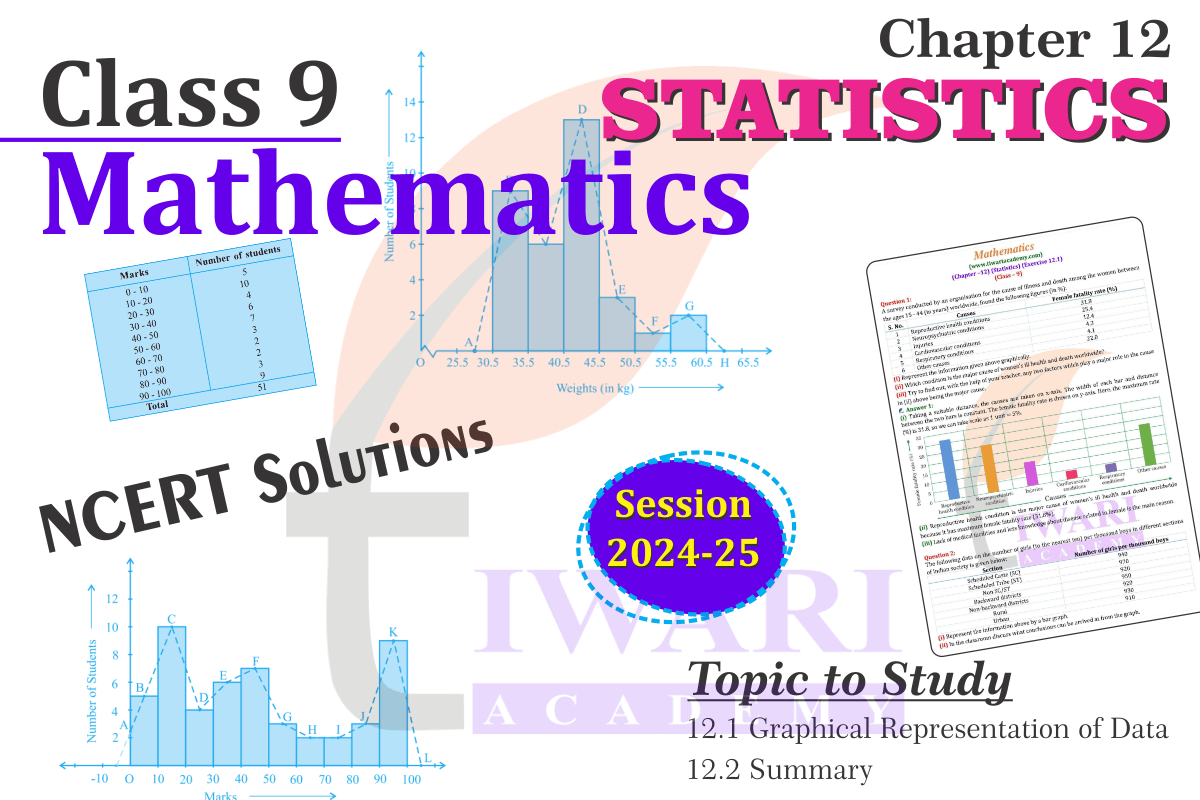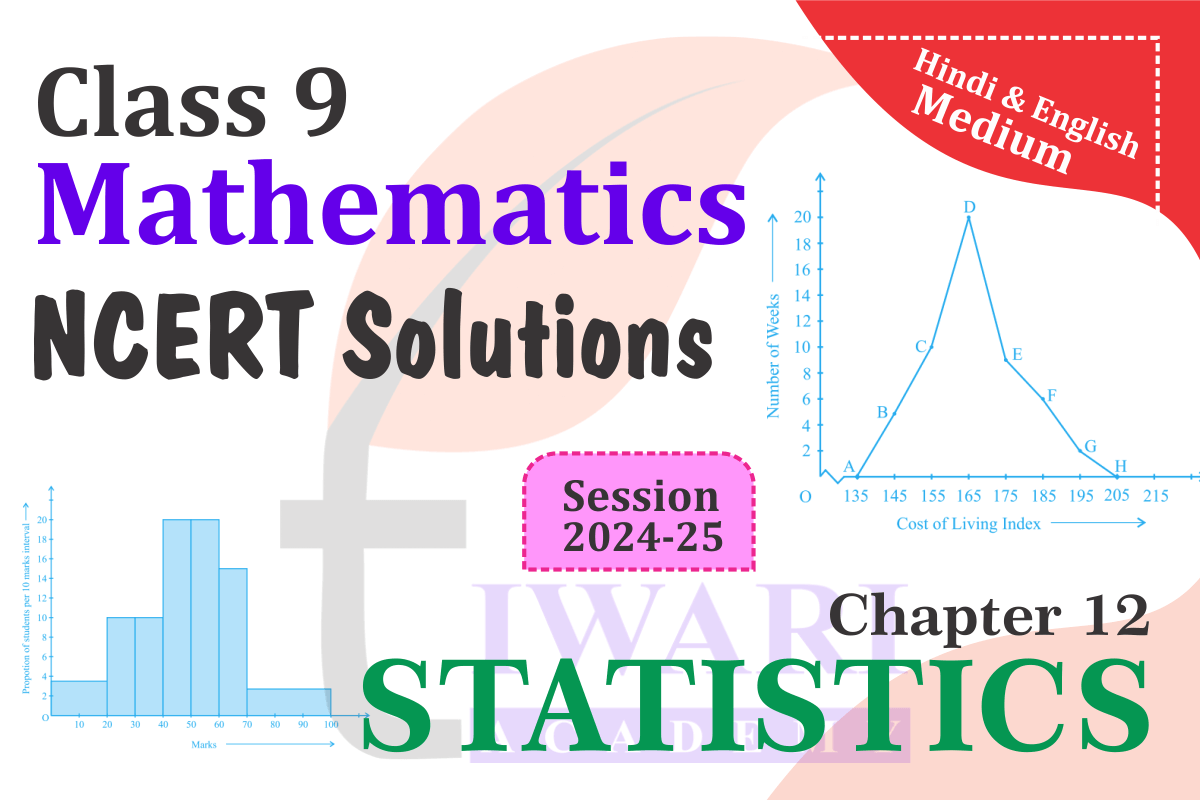NCERT Solutions for Class 9 Maths Chapter 12 Statistics in English and Hindi Medium prepared for new CBSE session 2024-25. For students to explore different resources and choose the ones that best align with their learning preferences and goals. According to revised curriculum and new NCERT textbook, there is only one exercise in chapter 12 of 9th Maths.
Class 9 Maths Chapter 12 Solutions for CBSE Board
Class 9 Maths Exercise 12.1 in English
Class 9 Maths Chapter 12 Solutions for State Boards
Class 9 Maths Chapter 12 Exercise 12.1
Class 9 Maths Chapter 12 Exercise 12.2
Additionally, the content and features of educational platforms can evolve over time, so it’s a good idea to check the latest offerings and user reviews to ensure that Tiwari Academy continues to support Class 9 Maths students effectively in 2024-25.
Class 9 Maths Chapter 12 Solutions in Hindi Medium
Class 9 Maths Exercise 12.1 in Hindi
NCERT Solutions for Class 9 Maths Chapter 12
| Class: 9 | Mathematics |
| Chapter 12: | Statistics |
| Number of Exercises: | 1 (One) |
| Content: | NCERT Textbook Solutions |
| Mode: | Text and Online Videos |
| Academic Session: | CBSE 2024-25 |
| Medium: | English and Hindi Medium |

The students of UP Board can use these solutions for class 9 Maths. It gives all the solutions of Prashnavali 12.1 in Hindi Medium. 9th Maths Chapter 12 sums are to study online in text and Video format. We update timely Class 9 Maths NCERT(https://ncert.nic.in/) Solution. It is good for new CBSE session 2024-25. Users of UP, MP, Gujarat and state board can take help.
Study Material for Class 9 Maths Chapter 12

9th Maths Chapter 12 Solutions in English & Hindi Medium
Get here the NCERT Solutions for Class 9 Maths Chapter 12 Statistics exercises solution which are given below updated for new academic session 2024-25. UP Board Class 9 Students are using NCERT Textbooks now. So, they can also download UP Board Solutions for Class 9 Maths Chapter 12 all Exercises. Download NCERT Solutions and UP Board Solutions Offline Apps based on latest CBSE Syllabus for all boards who are using NCERT Books 2024-25.
Class 9 Maths Chapter 12 Practice Question with Answers
What do you understand by data? What are the main data types?
Data: The facts or figures (observation / information collected) which are numerical or otherwise, collected with a definite purpose, are called data.
Data can be further divided into two categories as follows:
Primary data: The data collected by the investigator himself for a definite plan or purpose, is known as primary data.
Secondary data: The data which are not collected directly but obtained from some other sources (published or unpublished), is known as secondary data.
What is meant by Frequency Distribution of data?
Frequency Distribution: The number of entries of the data having their values lying in a class is defined as the frequency of the class. The table in which the corresponding frequency are written against each class, is called the frequency distribution of the given data.
What is meant by Class Interval? What is Class size?
Class Interval: Class intervals are the groups in which all the observations are divided. Each class is bounded by two figures or numbers which are called class limits. The difference between the upper limit and the lower of a class is called class size.
What is a Frequency Polygon?
Frequency Polygon: A frequency polygon is the polygon obtained by joining the mid-points of upper horizontal sides of all the rectangle in the histogram. It can also be drawn independently without drawing histogram. For this we find class mark of each class interval.
Important Notes on 9th Maths Chapter 12
Important Questions on 9th Maths Chapter 12
Give five examples of data that you can collect from your day-to-day life.
Five examples of data that we can collect from our day-to-day life: 1. Height of our classmates or weight of our classmate. 2. Height of first 100 plants near by our locality. 3. Maximum or minimum temperature of a particular month. 4. Time spend for watching TV in a particular week. 5. Rainfall in our city in last 10 years.
What do understand by primary or secondary data?
When the information was collected by the investigator herself or himself with a definite objective in her or his mind, the data obtained is called primary data. When the information was gathered from a source which already had the information stored, the data obtained is called secondary data.
What is statistics?
Statistics is the area of study dealing with the presentation, analysis and interpretation of data.
Mean: The mean of a number of observations is the sum of the values of all the observations divided by the total number of observations.
Median: Median is that value of the given observation, which divides it into exactly two parts.
Mode: Mode is that value of the given data, which occurs most frequently.
How many exercises are there in grade 9 Maths Chapter 12 statistics?
There is only one exercise in class 9 Maths Chapter 12 (statistics).
In exercise (Ex 12.1) has nine questions and five examples (examples 5, 6, 7, 8, 9). As per new syllabus, the rest exercises of statistics are deleted from class 9 Maths.
How many days, students need to complete chapter 12 of class 9th Maths?
Students need a maximum of 5-6 days to complete chapter 12 of class 9th Maths if they give a minimum of 1-2 hours per day to this chapter. This time also depends on student’s working speed, efficiency, capability, and many other factors.
What are the main topics in chapter 12 class 9th Maths Book to learn?
The main aim of chapter 12 of class 9th Maths is to make the following things clear to the students:
1. Meaning of data.
2. Primary data and Secondary data.
3. Raw data.
4. Range of the data.
5. Meaning of frequency.
6. Ungrouped frequency distribution table.
7. Class-Intervals, class-size, lower class limit, upper class limit.
8. Tally marks.
9. Grouped frequency distribution table.
10. Graphical representation of data
Is chapter 12 statistics of class 9th Maths difficult to solve?
No, Chapter 12 (statistics) of class 9th mathematics is not challenging. This chapter is nice and very easy, and also, this chapter is the student’s favourite chapter. Students enjoy doing this chapter.


